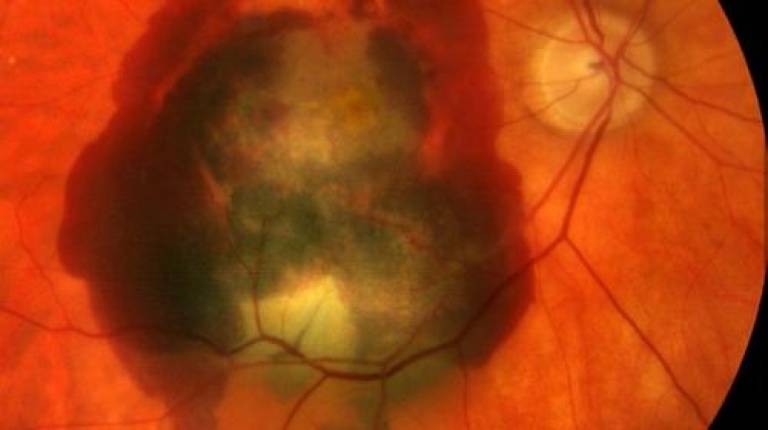New genetic clues to age-related macular degeneration revealed
6 January 2016

An international team of scientists including consultants from Moorfields and researchers at UCL’s Institute of Ophthalmology have identified 13 new genetic factors linked to the risk of age-related macular degeneration (AMD), a leading cause of vision loss among people age 50 and older.
The new findings widen the understanding of the biological processes that lead to AMD and could identify new therapeutic targets for potential drug development.
According to the research results, which were published in the journal Nature Geneticson December 23, a study of 43,000 people identified 13 new regions of the genome—called loci—that influence the risk of AMD. Worldwide this increases the number of known loci to 34.
The study’s principal investigators at Moorfields and UCL were Professor John Yates and Professor Tony Moore supported by genetic statistician Dr Valentina Cipriani, from the Institute of Ophthalmology and the Biomedical Research Centre based at Moorfields.
Commenting on the findings Professor Yates said: “Thanks to researchers from around the world pooling their resources and working together, exciting progress has been made in our understanding of the role of genetic factors in AMD. Identifying genetic variants that influence the risk of being affected by AMD helps us understand the causes of this serious condition and could contribute to the development of new treatments.”
Professor Tony Moore said: “The study contributes to a greater understanding of what could make potential future treatments work. For example for the first time the researchers involved also identified a variant specific to the neovascular form of AMD, which may point to reasons why therapy for this form of AMD is effective for some people but not everyone.”
AMD is a progressive disease that causes the death of the retinal photoreceptors, the light-sensitive cells at the back of the eye. While therapies for the other advanced form, neovascular or “wet” AMD, can successfully halt the growth of abnormal, leaky blood vessels in the eye, the therapies do not cure the condition, nor do they work for everyone.
Moorfields Eye Hospital and the Institute of Ophthalmology using clinical data and samples from a study that was started in Cambridge, made up one of the 26 centres worldwide which contributed to the International AMD Genomics Consortium. It was this consortium which collected and analysed the genetic data from 43,566 people of predominantly European ancestry for the study and systematically identified common and rare variations in genetic coding—called variants—associated with AMD. Common variants generally have an indirect association with a disease. Rare variants, by contrast, are more likely to alter protein expression or function and therefore have a direct or causal association with a disease. Rare variants were defined as those found in less than 1 percent of the study population.
Describing the contribution to the international consortium Dr Cipriani said: ”We contributed a total of 1,266 DNA samples. That was made up of 845 samples from patients with late AMD and 421 examined controls. The patients and controls were recruited mainly in Cambridge and Moorfields between 2002 and 2006.
“All subjects had colour, stereoscopic fundus photography of the macular region. All the images were graded at the Reading Centre at Moorfields Eye Hospital and we would like to thank the clinicians who helped with recruitment and the Reading Centre for grading fundus photographs and the subjects who participated in the research.”
Worldwide the study included 23,000 participants with AMD and 20,000 without it. The researchers analysed DNA samples from both groups, surveying most of the genome, but also focusing in on distinct loci already known or suspected to be associated with AMD. Next, they compared the participants’ DNA to a reference dataset called the 1000 Genomes project, yielding more than 12 million genetic variants of potential interest. Finally, they went back to the participants’ DNA samples, looking at all 12 million variants, to see if any were found more or less often in people with AMD than those without it.
“These variants provide a foundation for genetic studies of AMD going forward,” said one of the senior authors, Jonathan L. Haines, Ph.D., of Case Western Reserve University in Cleveland. The next step is to investigate what the variants are doing to the genes and how they affect gene function. Do they turn them on or off? Do they interact with other genes spurring a series of events along a pathway that leads to AMD?”
Additionally, 10 of the variants point to genes involved in maintaining the extracellular matrix, the nonliving material amongst cells that provides structural support and nutrients. Researchers have theorized that abnormalities of the extracellular matrix occur in people with a subtype of AMD that develops without early-stage signs, or that quickly worsens before such signs are detected. If confirmed, a connection between AMD and these extracellular matrix genes may allow for predictive genetic tests and more effective therapies for people with this type of AMD.
“Even with the pooling of genetic information from such a large population, the variants identified by the international consortium still cannot account for all of the heritability of AMD,” said Grace L. Shen, Ph.D., a group leader and director of the retinal diseases program at NEI. “We are, however, on track for discovering important variant genes that may play a role in AMD heritability.”
 Close
Close

